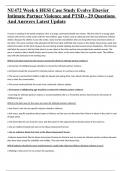Exam (elaborations)
NU472 Week 6 HESI Case Study Evolve Elsevier Intimate Partner Violence and PTSD - 29 Questions And Answers Latest Update
- Course
- Institution
NU472 Week 6 HESI Case Study Evolve Elsevier Intimate Partner Violence and PTSD - 29 Questions And Answers Latest Update
[Show more]



